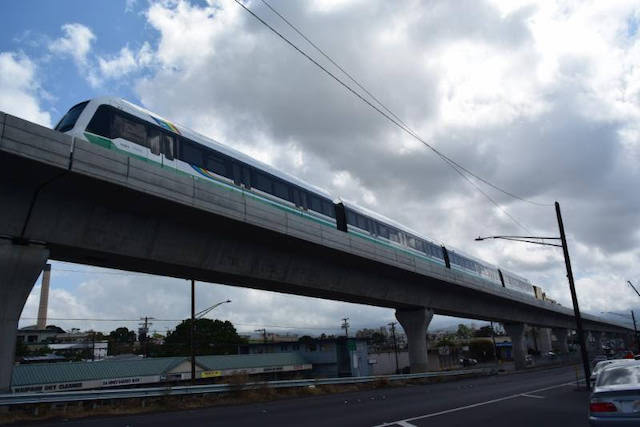The Honolulu Authority for Really-overpriced Transportation (HART) says that early reports of ridership on its new rail line only included people who paid full fares but not people who boarded with a transit pass. When all riders are counted, the rail line carried about 4,000 riders a day in its first week, about double its early reports.
Another nearly empty train obstructs views in Honolulu. Photo by HART.
Even 4,000 is a little short of the number that HART projected it would attract once the system is completed: 84,000 people a day. Unfortunately, the agency hasn’t published ridership estimates for the portion of the line that opened on June 30, but I doubt they would be anywhere near as low as 4,000 a day.
When the Antiplanner reported on the opening of the rail line last week, I calculated that the line’s capacity was 65,600 riders a day. That’s based on current schedules of six trains per hour for 13-1/2 hours a day and train capacities of 800 riders. Of course, some people could get off before the end of the line allowing others to get on. HART could also increase capacities by increasing frequencies.
So the rail line should be able handle 84,000 people a day if that many people ever want to ride it. I doubt that will ever happen.
HART projects operating costs will be about $100 million a year for the line that is currently open increasing to $160 million a year if and when it is ever completed. The city of Honolulu currently operates 106 bus routes at an operating cost under $210 million a year, so the $160 million cost of operating the full rail line represents a 76 percent increase in transit operating costs for just one new route.
If the line is ever completed, I suspect actual ridership will be less than half of projections or roughly 40,000 riders per weekday. At an average fare of $1 (which is more than the city collects from bus riders), that’s about $12 million a year or 7.5 percent of projected operating costs. The current truncated line, which serves the least-densely population portion of the entire route and reaches no real destination other than a football stadium, will probably never come close to half of the full line’s ridership. If it ever carries 10,000 riders a weekday, fare revenues will be about $3 million a year, or 3 percent of operating costs.
Based on this I suspect HART will more likely end up reducing frequencies rather than increasing them simply because it won’t be able to afford to continue to operate trains that are less than 10 percent full. Since the federal government won’t allow the city to simply stop running the trains without demanding that it repay the billions the FTA granted for construction, local taxpayers will be stuck paying the bills for this boondoggle for a long time.









“Since the federal government won’t allow the city to simply stop running the trains without demanding that it repay … ”
How about this … HART tells the feds to go pound salt because they (the feds) have far more experience than HART and knew or should have known how low ridership would be.
“… HART tells the feds to go pound salt because they … knew or should have known ….”
Great point! The case could also be made that empty and near-empty buses have large carbon footprints and should—no, MUST—be shut down in the name of saving the planet!
”
HART projects operating costs will be about $100 million a year for the line that is currently open increasing to $160 million a year if and when it is ever completed. The city of Honolulu currently operates 106 bus routes at an operating cost under $210 million a year, so the $160 million cost of operating the full rail line represents a 76 percent increase in transitoperating costs for just one new route.
“
Interesting to see how the numbers will look after a few months worth of data has been collected, assuming hart deigns to share such with the great unwashed (us).
I’m wondering how they will apportion the revenues between rail and bus, and how much the effective $ yield per ride turns out to be. The $1 mentioned seems about right when you account for free transfers, a $7.50 daily limit and $80 monthly limit on charges to the holo card for adults. There are also discounted fares for children, students, disabled and seniors. The senior fare is especially notable because an unlimited yearly pass is only $45.
Just fyi, the actual fare box recovery ratio for Honolulu’s Department of Transportation Services for FY 2022 was 13.56%. For FY 2023 it’s estimated at 14.74%, and for FY 2024 it’s projected at 14.20%. Source: Honolulu Department of Transportation services FY 2024 budget. If anything, I think it will be even lower now that our vastly underutilized, extremely expensive rail has been added to the mix.